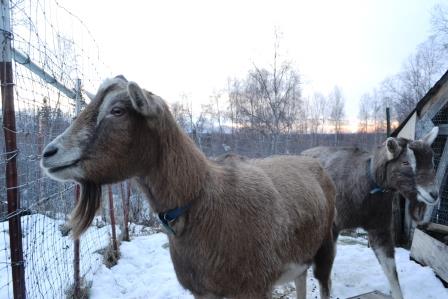
Home > Dispatches > Daily Dispatches 2014 >Daily Dispatch #337
December 18, 2014: Book Review: Part II, Animals Make us Human
Temple Grandin’s book is written in such a way that her audience is forced to reflect upon their own animal husbandry handing habits. This is because she uses self-observation and self-example so effectively. For example, Grandin writes about stereotypical behavior, which is abnormal and usually repetitive behaviors, some human (she was a shoe scuffer) but mostly animal. In the horse world, weaving, cribbing, and wood chewing fit in with her definition. |
|
| Grandin says that stereotypic behaviors are less likely when people take an animal’s physical and mental welfare into account. To this end, she provides readers with what she calls the five freedoms – physical welfare related freedoms are freedom from hunger and thirst, freedom from discomfort, freedom from pain, injury, or disease. And the mental welfare related freedoms are freedom to express normal behaviors and freedom from fear and distress. Like other pet owners, I thought about our animal groupings in reading Grandin’s book. First of all, there are our horses. I have not seen any stereotypic behavior. They do live in a small pen (and this pains me) but I compensate for this, by getting them out nearly every day, and also feeding them frequently. And in the winter I spread their hay out on the snow, so that they move about when eating. I’ve also begun doing horse agility with them, which they seem to enjoy as much as being out on the trail. Then there are the dogs. Grandin recommends that dogs get at least an hour of attention a day. Our dogs get taken out on a daily basis, sometimes for two-three hours at a stretch. And their food and water needs are always met. Then there are the goats. I haven’t seen any stereotypic behaviors here. They have okay digs – they reside in an enclosed shelter that they can go in and out of at will. And they live in a decent sized, enclosed pen. I feed them as often as I feed the horses. One thing that’s bothered me is that trimming their feet, for us and for them, has always been a major ordeal. After reading how Grandin had success in dealing with pronghorn antelope, I decided to emulate her. I am now using the clicker and positive reinforcement in getting them to give their feet to me in a willing fashion. So far, so good – it’s slow going because they feel as though they’ve been traumatized. If I remain patient, and I will, they will in the long run be happier about having this procedure done. And then there are the chickens. Reading Grandin’s chapter on poultry management about turned my stomach. Older layers, in particular, have suffered a great deal at the hands of bad management. I cannot save the world and take on any more chickens than I have on hand. This is because we don’t have the facilities to take on any more. But I know that Sophie, Chickaroo, and Freebird have it quite good. They have a coop and a box, and they get out in good weather. I would and might like to make them a chicken tractor. I guess I’m doing my little bit to make the world a better place. If everyone did this, the world would indeed be a better place. |
|
